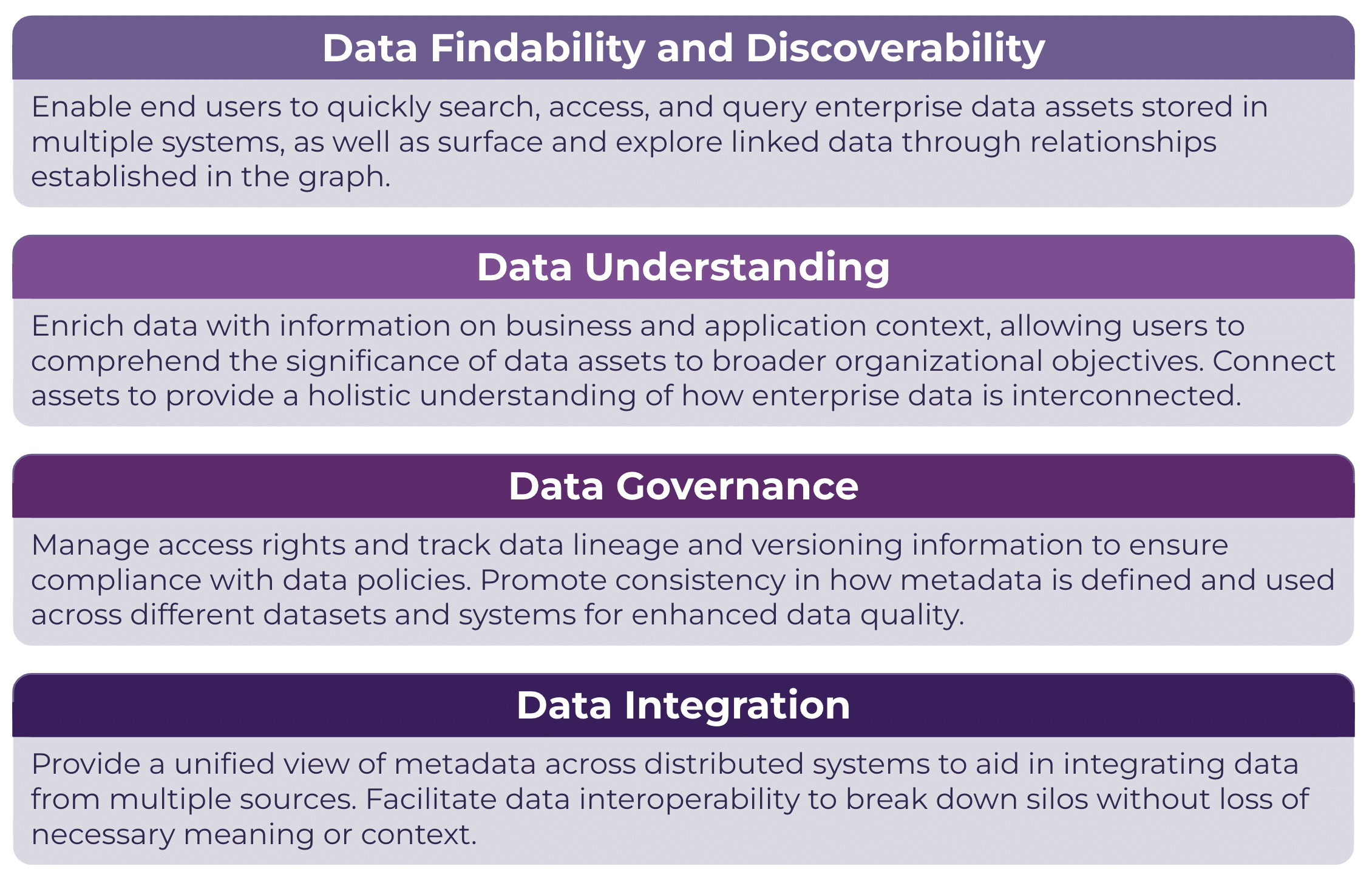Modern data landscapes are characterized by immense volumes of diverse, disparate, and dynamic data sources, leaving many organizations struggling to effectively manage and derive value from their data assets. To address these challenges, a metadata knowledge graph serves as a valuable tool for metadata management in the semantic layer, as it enables organizations to easily identify and contextualize what kind of data they have across their information ecosystems. A particular application of an enterprise knowledge graph, a metadata knowledge graph provides a structured way to organize, connect, and understand knowledge and data assets with corresponding data provenance and usage information for an end-to-end view of organizational data.
While an enterprise knowledge graph encompasses all data entities and actual data instances across an organization, a metadata knowledge graph specifically focuses on gathering and managing metadata, or information about data entities, attributes, relationships, and their context. Aggregating and surfacing contextual information in the form of metadata – from what data is collected to how it is consumed – ultimately supports data accessibility, findability, traceability, connectivity, governance, and understanding across the enterprise. In this blog, I will detail the kind of metadata that is useful to capture in a metadata knowledge graph and how leveraging this tool enhances an organization’s ability to extract value from their enterprise data.
Understanding the Metadata Knowledge Graph
A metadata knowledge graph acts as a unifying layer, integrating different types of data from various sources and capturing rich, descriptive metadata to create a holistic view of an organization’s knowledge ecosystem. For datasets in use across the enterprise, we can associate contextual metadata regarding data sourcing, ownership, versioning, access levels and entitlements, consuming systems and applications, and other relevant details in a single location. For example, EK is advising a global financial institution on modeling an extensible metadata knowledge graph as part of their semantic layer-driven data strategy. The firm’s metadata knowledge graph captures provenance and usage information for their numerous taxonomies, ontologies, knowledge graphs, and related data assets to enhance data awareness and understanding for regulatory compliance and reporting needs.
The kinds of metadata captured in a metadata knowledge graph commonly fall under the following high-level types:
- Business metadata gives data meaning in the context of an organization and its knowledge domain, as it includes information such as the business definitions of data elements, business rules that govern the data, and relationships between datasets. Capturing this metadata is key for understanding the business-specific context of data and how data should be leveraged to address business needs and use cases.
- For the financial firm, their key business metadata includes names and descriptions or purpose statements for their published taxonomy and ontology models, as well as which business areas or systems currently manage and/or consume these models. This helps the firm understand the business context of what data is being used and shared across the organization.
- Technical metadata is information on technical data characteristics, such as data format, type, structure, and location. Technical metadata is important for data management and integration processes to enhance data accessibility and interoperability.
- The firm’s metadata knowledge graph captures extensive technical metadata related to their semantic models, such as API details for integrating particular taxonomy data in various contexts. This facilitates data aggregation for their regulatory risk assessment and reporting processes.
- Operational metadata is information about how, when, and where data is created, processed, accessed, stored, and transformed. This metadata is leveraged to monitor the flow of data and maintain appropriate levels of data quality, consistency, and accessibility in support of effective data governance and change management practices.
- The financial firm’s metadata knowledge graph gathers operational metadata primarily in support of change management and governance needs. This metadata includes model versioning information, details on deprecated taxonomy terms or ontology classes, entitlement restrictions, and other usage and data quality metrics.
The Value of a Metadata Knowledge Graph
Building a metadata knowledge graph simplifies and streamlines data and metadata management practices. By capturing relevant business, technical, and operational metadata of an organization’s data assets, end users can quickly identify and leverage datasets relevant to their day-to-day needs or broader use cases with a deeper understanding of business context. Collecting comprehensive and consistent metadata in a metadata knowledge graph offers the following key benefits to empower data-driven processes and decision-making at all levels of an organization:

Upon implementation, metadata knowledge graphs can power a wide range of applications, such as dashboards and visualization tools, semantic search, and reporting and analytics platforms. These tools enable intuitive user interactions with enterprise data, streamlining abilities to surface, relate, and aggregate siloed information. This reduces burdensome manual efforts in managing disparate data and provides users a holistic view of information assets to answer key business questions. EK supported the financial firm in modeling their metadata knowledge graph to enable semantic search and discovery across their enterprise data models with a single user interface. This offers a user-friendly, centralized approach for firm employees to quickly locate, understand, and connect information for complex financial regulatory reporting at their time of need.
Conclusion
By consolidating business, technical, and operational metadata into a unified framework with a metadata knowledge graph, organizations can enhance data findability and accessibility, foster a deeper understanding of business data assets, promote alignment with data governance practices, and facilitate seamless data integration across diverse systems. The metadata knowledge graph empowers organizations to eliminate data silos and leverage their data assets more effectively for consistent knowledge sharing and context-driven decision-making across the enterprise. Contact EK to learn more about modeling and implementing a metadata knowledge graph for your semantic layer.
